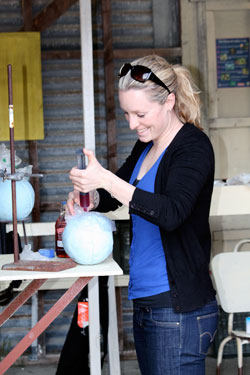 Monday 2 May 2016 9:19am
Monday 2 May 2016 9:19am
Gemma Radford,
Anamomy and Structural Biology graduate,
Forensic Biology (Masters).
When Masters student Gemma Radford was offered the chance to build a model of cranial back-spatter, wild horses probably couldn't have kept her from turning it down. The Anatomy and Structural Biology graduate had always wanted to work in forensics, but never dreamt she'd get the opportunity to work on a world-first project so soon in her research career.
Gemma's Masters project is the construction of a cranial back-spatter model, funded by crown research institute Environmental Science and Research (ESR). Her supervisor Professor Jules Kieser has, together with some of his postgraduate students, been working with ESR Forensics for a number of years on projects ranging from blood-spatter and wounding to mitochondrial DNA. He says that ESR recognized the potential significance of Gemma's work.
"For example, lots of evidence in the Bain case was contradictory, particularly in the interpretation of blood-spatter from close range shots. This illustrates how important Gemma's work is."
Back-spatter is the term given to blood and tissue that issues from the entry wound caused by a bullet and moves back towards the person shooting the firearm. While models for recreating and analyzing this phenomenon exist, Gemma's is the first to attempt to as closely as possible approximate a human head, despite the frequent importance of such evidence in homicide cases.
Gemma's research involved constructing a model head, which as closely as possible approximates a human one, using silicone, resin and gelatine. She injected it with pigs' blood before a ballistics specialist then shot at the model with a police hand gun, and the resulting blood-spatter was analysed. Comparisons with the back-spatter from pig heads shot under the same conditions were also conducted.
Further research will be required to perfect the model, but Gemma says her thesis will contain valuable data that will assist the ongoing development of the cranial back-spatter model.
"The model seems to be quite realistic, based on comparisons to pig heads and observations from literature, but more work needs to be done before we will be able to confidently say it is comparable to a human head."
"The next stage will be to do some mathematical modelling as well as further tests on the various materials used in the model. This will need to be carried out by researchers with experience in those areas and therefore my involvement with the project will end."
With the long-term aim of working in forensics internationally, Gemma plans to continue with a PhD in this area.
"I really like the fact it is a multidisciplinary field with so many possible areas of research and I think working as a forensic scientist would be a challenging job where every day is different. Doing a Masters has also made me realise how much I enjoy research, so I am keen to do more in the future."
For more information
http://dentistry.otago.ac.nz/staff/juleskieser/studentprojects/studentprojects.html

